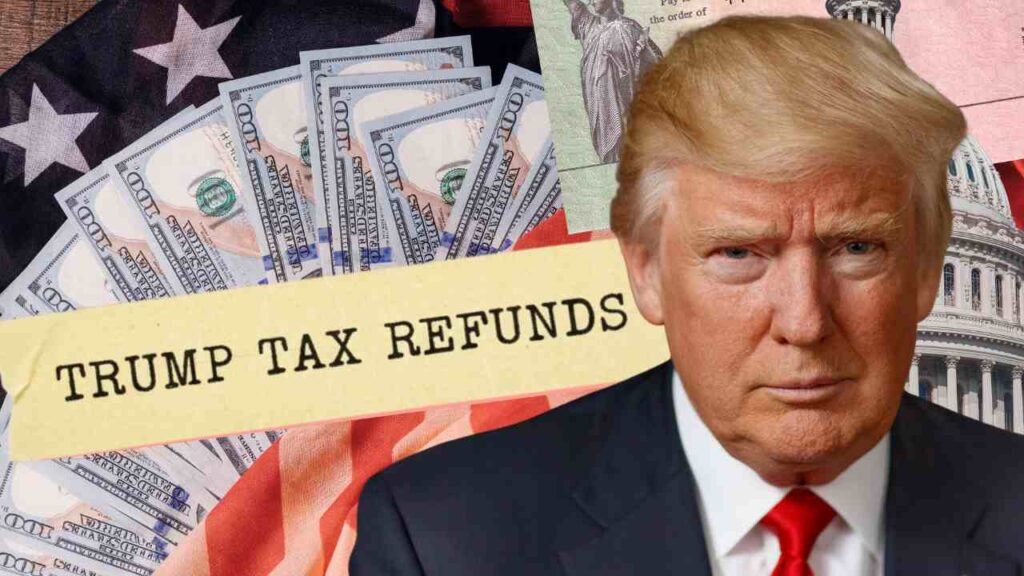On July 2025, President Donald Trump signed his flagship as the most powerful man in America: One Big Beautiful Bill Act (OBBBA) into law—a sweeping tax package that extends key provisions from his 2017 Tax Cuts and Jobs Act while introducing new tax breaks.
This super huge legislation was designed to deliver immediate tax relief, while it also includes retroactive elements effective from January 1, 2025. The big twist? Many Americans will feel the full impact not through smaller paychecks now, but through substantially larger tax refunds when they file their 2025 returns in early 2026.
Why Trump just made your next tax refund bigger than last year
According to economic analyses, this could inject an extra $50 billion into Americans’ pockets via tax refunds—an 18% jump from the $275 billion in refunds the IRS issued for 2024 returns (averaging about $2,939 per filer). Why the delay in benefits?
The IRS hasn’t yet updated employer withholding tables for 2025, so your paycheck deductions are still based on pre-OBBBA rules. This leads to over-withholding throughout 2025, meaning you’ll get the money back as a lump-sum refund next year instead of seeing it spread out now.
How it works: Trump’s OBBBA mechanism for tax refunds
Under normal tax rules, your employer withholds a portion of your paycheck based on IRS guidelines to cover your estimated federal income tax liability. OBBBA lowers that actual liability for 2025 income through deductions and exemptions, but unchanged withholding means you’re prepaying more than you owe. When you file your return in 2026:
- The IRS recalculates your taxes using the new, lower rates and higher deductions.
- Any overpayment (from withholding) is refunded to you.
- Result: A “windfall” refund that feels like a bonus check.
This retroactive setup was intentional—Trump touted it as a way to “surprise” Americans with bigger returns at tax time, boosting consumer spending in 2026. However, if you want the benefits sooner, you can adjust your W-4 form with your employer to reduce withholding now (use the IRS withholding estimator tool for guidance).
The fundamental provisions driving the bigger refunds
OBBBA’s tax cuts target specific income types and demographics. Here’s a breakdown of the main ones affecting refunds:
| Provision | Description | Impact on Refunds |
|---|---|---|
| No Taxes on Overtime & Tipped Income | Exempts certain overtime pay and tips from federal income tax (up to specified limits, like $10,000 in tips annually). | Downgrades taxable income directly; workers in service industries (e.g., waitstaff, delivery drivers) or hourly jobs could see $500–$2,000 extra in refunds, depending on how much they earn. |
| Higher SALT Deduction Cap | Raises the limit on deducting state and local taxes (SALT) from $10,000 to $40,000 for itemizers. | Big win for homeowners in high-tax states like California, New York, or New Jersey; could add $1,000–$5,000+ to refunds for middle-to-upper-income filers. Total expected savings: $5.1 billion. |
| Senior Deduction Boost | New $6,000 additional standard deduction for those 65+ (phasing up to $12,000 in some cases). | Lowers taxable income for retirees; expect $800–$1,800 more in refunds per qualifying senior household. Total estimated savings: $9.3 billion. |
| Extended 2017 Tax Cuts | Permanently lowers individual income tax rates and doubles the standard deduction. | Broadened relief across brackets; the average household could see $750–$3,500 more, with the full effect hitting via refunds. |
| 100% Bonus Depreciation | Businesses can entirely deduct eligible equipment purchases in year one. | Indirect boost for self-employed or business owners; flows through to personal returns, potentially adding thousands for entrepreneurs. |
Who benefits most (and by how much) with the new tax refunds rules
The bill favors higher earners and some particular groups, according to analyses from the Tax Policy Center and Congressional Budget Office.
Lower income households get small gains while the top 20 percent — with incomes of more than roughly 217,000 — take about 60 percent of the benefits. Here’s a rough estimate of average annual tax savings which turn into boost in refunds by income level:
| Income Range | Estimated Tax Savings (Refund Boost) |
|---|---|
| $0–$34,600 | $150 |
| $34,601–$66,800 | $750 |
| $66,801–$119,200 | $1,780 |
| $119,201–$217,100 | $3,460 |
| $217,101+ | $12,540 (up to $75,410 for $1M+ earners) |
Lower earners might see smaller, absolute dollars, but could still feel the difference if they earn tips or overtime. Overall, about 94 million filers like this year are eligible, but exact amounts will depend on your situation. Use the Tax Foundation’s OBBBA calculator to help figure out your approximate take.
